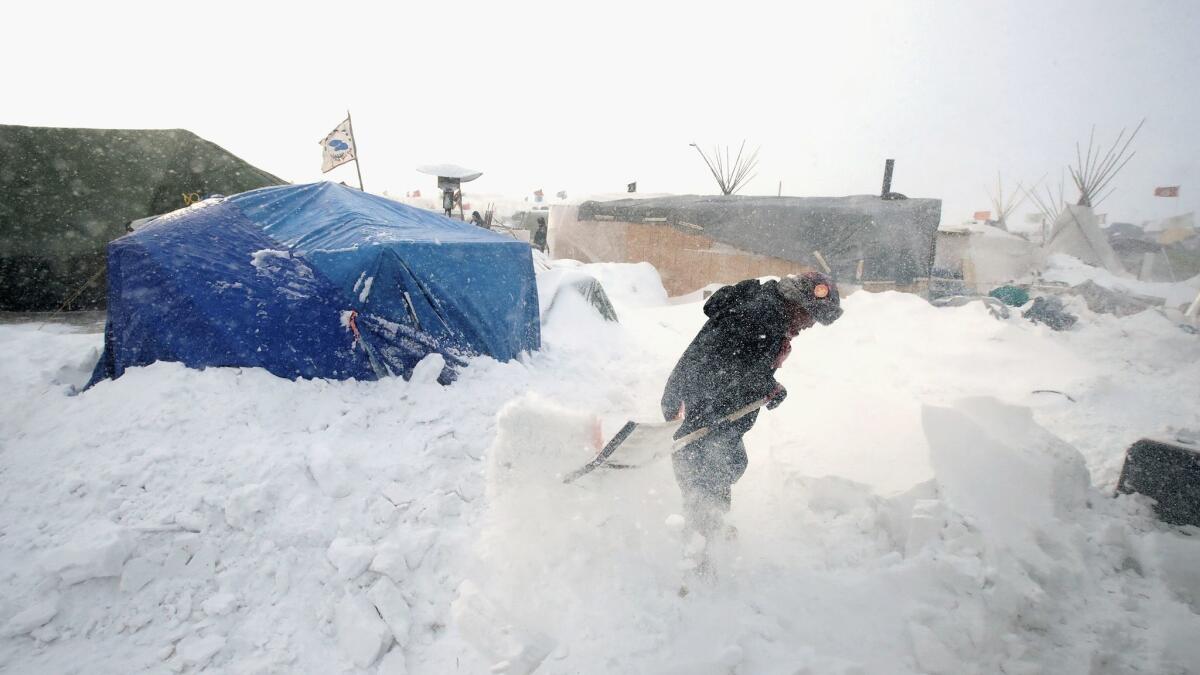The latest challenge for Dakota Access pipeline protesters: A punishing blizzard

More than 1,000 people protesting the Dakota Access pipeline have taken refuge in community centers and a casino on the Standing Rock Sioux Reservation since a powerful blizzard blew through their main camp.
High winds knocked down a large military-style tent in the Seven Council Fires encampment late Monday. The tent caught fire, which spread to two other tents.
The blaze displaced dozens of people, who crowded into another tent and huddled together for warmth, said Desiree Kane, who has been living at the camp since August.
No injuries were reported in the fire. But amid plummeting temperatures and near white-out conditions, several dozen people were treated for hypothermia as camp medics oversaw a partial evacuation, starting with women and children.
A team of 20 medics scoured the camp in pairs overnight Monday, “going from structure to structure, taking them to safe spaces,” said Linda Black Elk of the Standing Rock Medic & Healer Council.
Many protesters were taken to “warming centers” in the town of Cannon Ball a few miles away. Others were driven seven miles to the Prairie Knights Casino and Resort, joining many of the estimated 2,000 military veterans who arrived this week to join in solidarity with the Sioux and other Native Americans in their fight against the pipeline.
At least 1,000 people filled the Pavilion, a cavernous music venue at the casino, steps from slot machines and blackjack tables.
“People are under the bleachers, behind the curtains,” Kimberly Klaas, a volunteer with the veterans’ contingent, said Tuesday. “The floor was pretty full last night. I saw people sleeping in stairwells.”
Guest rooms at the accompanying lodge were packed with up to nine people each, sleeping three to a bed with others on the floor. “I don’t think anybody got much sleep,” Klaas said.
In the wake of the blizzard, Standing Rock Sioux Tribal Chairman David Archambault called for pipeline foes to abandon the encampment.
“We deeply appreciate all the people who supported us with their presence,” Archambault said in a statement, “but when this storm passes, it is time to dismantle the camp and return to our homes. If the camp stays where it is currently located, people are risking their lives.”
From the casino Tuesday, veterans and Native American leaders called for help for the vulnerable back at the camp. A Navy veteran and member of the Indigenous Veterans Council at Standing Rock who goes by one name, Remy, said four-wheel-drive trucks with tire chains were needed to ferry supplies to the camp and bring people out.
“We’re going to have to start a caravan to take supplies there, like propane heaters,” he said.
On Tuesday, the National Weather Service issued a new blizzard warning, predicting gusts of up to 55 mph and zero visibility amid blowing snow. Conditions remained treacherous at the camp, which was established several months ago to protest construction of the 1,172-mile, $3.8-billion oil pipeline.
Opponents of the pipeline fear that an oil spill would contaminate the water supply for the reservation and 17 million other people who rely on the Missouri River.
The U.S. Army Corps of Engineers declared Sunday that it would not grant an easement to Energy Transfer Partners, the company building the pipeline, to tunnel under the Missouri River — at least until the agency can complete an environmental impact statement.
The protesters, who prefer to be called “water protectors,” see the Corps’ ruling as a temporary victory. But they barely had time to celebrate the decision before the storm moved in.
In his statement calling for an end to the camp, Archambault cited the Corps’ decision. “Energy Transfer Partners cannot cross the easement, even if they drill,” he said. “Not only will they jeopardize the entire pipeline project, but they will also jeopardize their investors’ money and their bank loans.”
Many pipeline opponents remained skeptical. “I think some people will go home; others will not,” said Kane. She and many other water protectors believe Energy Transfer may directly violate the Corps’ ruling, given how much the company has invested in the project to date. “I think they will likely suck it up and pay the fines,” she said.
Noah Morris, a camp medic, expressed frustration that so many people had arrived in North Dakota unprepared for the harsh winter conditions.
“Some of the veterans, bless their hearts for coming out,” he said. But “we have been begging people not to show up” unless they have proper gear.
At the casino, there was a strong sense of fellowship among the veterans, Native Americans and other activists.
“People are hunkering down and cooperating in a beautiful way,” said Kane, a 33-year-old of Miwok heritage who came from her home in Denver to join the protest. “The intent in which this movement began has carried through even in this moment of crisis.”
Tolan is a special correspondent.
ALSO
What’s next for the Dakota Access pipeline
Army halts Dakota Access pipeline: ‘Today, the voices of indigenous people were heard’
State lawmakers may tell California pension funds to divest from Dakota pipeline companies
UPDATES:
6:15 p.m.: This article was updated with a statement from Standing Rock Sioux Tribal Chairman David Archambault.
This article was originally published at 3:25 p.m.
More to Read
Start your day right
Sign up for Essential California for news, features and recommendations from the L.A. Times and beyond in your inbox six days a week.
You may occasionally receive promotional content from the Los Angeles Times.






